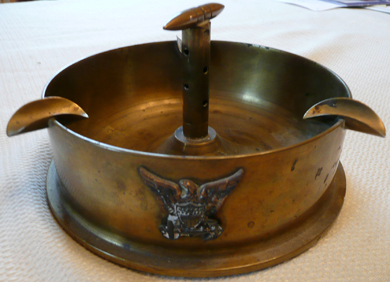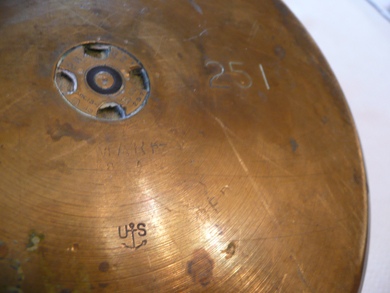 |
|
|||
 |
 |
|||
RINKER ON COLLECTIBLES — Column #1463 Copyright © Harry Rinker, LLC 2014 Questions
and Answers
QUESTION: I have a brass ashtray. The base is six inches in diameter and about three inches high. There are three attached pieces, each of which would hold a cigarette or cigar. The center round plinth has a three-dimensional bomb/bullet on the top. There is an applied eagle on the front. The curved bottom has “US” with an anchor between those letters and “251.” The entire unit weighs a little over five pounds. Any information about my ashtray would be appreciated. – KJ, Bozman, MT
ANSWER: You own a piece of World War II trench art. Trench art is a generic term used to describe items made by civilians, prisoners of war, or soldiers from discarded material from an armed conflict. The earliest examples date from the Napoleonic Wars. The practice enjoyed numerous renaissances, especially during World War I and World War II. There is no limit to the type of material produced. Ashtrays, boxes, bracelets, cigarette cases, lamps, letter openers, lighters, jewelry, and vanity kits are a few examples. Embossed shell casings featuring a war scene and location were popular during World War I. Trench Art divides into four categories: (1) soldier-made items, (2) POW and Internee items, (3) civilian-made items, and (4) commercially-made items. In theory, soldier-made items were made while the soldier was at the front. However, wounded soldiers often were encouraged to create trench art as a form of therapy. Some “trench art” was created following a war. Local towns and villages recycled material from military scrap heaps to fashion goods for sale to tourists. In some cases, commercial firms found material of historical significant, cut it down, and sold it with an attached plaque or tag touting its importance. The base of your ashtray is an artillery shell. The ashtray appears to be soldier-made but could be civilian made. The format is one of the most common types of World War II trench art available. The asking price for similar pieces at an antiques and collectibles flea market or mall ranges from $35.00 to $45.00.
QUESTION: My grandfather, Burnell E. Weirick, was president of the Kalamazoo Sled Company in the late 1940s. I am trying to find out information as to the meaning of the numbers found on the back of the sleds so that I can identify those sleds made during his tenure as president. Can you help? – BH, Email Question ANSWER: The Page Manufacturing Company, located at the corner of Third and Sheraton in Kalamazoo, Michigan, was founded in the 1870s as a manufacturer of wood parts for horse-drawn buggies. On February 14, 1894, Page was reorganized as the Kalamazoo Sled Company. By 1905, the Kalamazoo Sled Company had absorbed the Columbia Sled Company and employed more than 100 workers. Like many sled companies, it made a wide variety of wooden products such as croquet sets, lawn furniture, and wooden handles for feather dusters in the off season. Of course, the company was known for a wide range of model sleds. The “Champion” line was its most popular. In the 1950s, the Kalamazoo Sled Company produced the “Champion Flying Disk.” Although ownership changed, the company survived into the 1970s. [See: http://www.kpl.gov/local-history/business/kalamazoo-sled.aspx.] I located a copy of US Patent 2,526,100 issued on October 17, 1950, obtained by Burnell E. Weirick for an improvement to the knee structure. The application was submitted on May 29, 1946. The length of time between the application and granting of the patent suggests the Patent Office needed several questions clarified before granting the patent. After examining several dozen images on the internet, I concluded the numbers on the back of the sled are “model” and not “serial” numbers. Assuming I am correct, you need to find copies of Kalamazoo Sled Company catalogs from the period when your grandfather was president to see what models were made. Start by contacting the Kalamazoo Public Library (1000 West Paterson Street, Kalamazoo, MI) to see if they have a historical file on the Kalamazoo Sled Company. I could not find any listing for a local historical society but did find a listing for a Kalamazoo Valley Genealogical Society, whose website www.mikvgs.org has a link to historical records at the Western Michigan University Archives and Regional History Collections. Consider obtaining a copy of Joan Palicia’s “Flexible Flyer and Other Great Sleds for Collectors,” published by Schiffer Publishing in August 1997 and/or “Great Sleds & Wagons,” published by Schiffer Publishing in 2009. You also might try writing or emailing Joan. Her address is 15 Canton Road, Wayne, NJ 07470, and her email is jpsledssnofn@nac.net. The difficulty is that most models could have been made before or after your grandfather’s tenure. Pinning down an example made during your grandfather’s tenure will be difficult. Your best approach is to find a sled that incorporates the patent design change invented by your grandfather. QUESTION: I have a Radicon bus, a remote controlled toy, in its period box. The box is marked “MT” [Modern Toys] and “Made in Japan.” What can you tell me about the history of this toy and its value? – K, Reading, PA ANSWER: Modern Toys is a brand name used by Masudaya, one of Japan’s oldest toy companies. Founded in 1924, Masudaya was and remains a leading manufacturer of battery operated and mechanical toys in the post World War II era. Its logo is a ‘T” above the letter “M” in a diamond lozenge. Masudaya’s product lines included aircraft, civilian vehicles, military vehicles, and robots and other space toys. The 1957 Radicon Robot was the first remote controlled robot. The company’s present day survival is attributed to its transition to producing skirmishable airsoft rifles. [See: http://en.wikipedia.org/wiki/Masudaya_%28airsoft%29 and http://rodgersantiques.co.uk/?p=1222] Your Radicon bus dates from the 1950s. The complete unit consists of four parts: (1) the metal gray bus with plated parts, (2) the metal gray control box, (3) an instruction booklet, and (4) the period box and cardboard inserts. The bus requires three batteries as does the remote control unit. The range of motion is limited. The bus slowly ran in circles. The Radicon bus is considered by many to be the “first” remote controlled toy. Among hobbyists, “Radicon” has become a generic trade name for all remote controlled toys, similar to terms such as Kleenex and Xerox. A Goodwill Store in Orange, California, offered a Radicon bus for sale at $136.99. WorthPoint.com notes that a complete Radicon bus sold on eBay on May 26, 2011 for $240.49. Two hundred and fifty dollars is a reasonable price. Although scarce, examples appear regularly for sale online, both in auctions and by toy dealers. QUESTION: I just purchased a 1939 World’s Fair Firestone tire ashtray with a clear insert. I notice that it does not have “1939” over the embossed buildings. I have seen both types of Firestone tire ashtrays on eBay. Is it possible I purchased a reproduction? – WR, Sturgis, MI, Email Question. ANSWER: There is a simple explanation for the two versions of this Firestone tire ashtray. The 1939 New York World’s Fair was actually the 1939-1940 New York World’s Fair. The fair had two seasons. It shut down during the 1939-1940 winter. The Firestone tire ashtray had the 1939 date when it was handed out that year. To save the expense of a new die, Firestone simply had the 1939 date removed from the die for the ashtray. The cost to create a new die with “1940” was considered extravagant. Roy Nuhn, in a February 2005 article on tire ashtrays in the “Antiques Shoppe Newspaper,” wrote: “The manufacturers halted the production and distribution of advertising rubber ashtrays sometime during the 1980s, mainly due to high production costs. The molds alone could cost as much as $25,000. This is of some advantage to collectors, because the high cost of making the tobacco novelties is so high that it also prevents anyone else from turning out reproductions.” [http://antiqueshoppefl.com/archives/rnuhn/ashtray.htm]Harry L. Rinker welcomes questions from readers about
collectibles, those mass-produced items from the twentieth and twenty-first centuries.
Selected letters will be answered in this column.
Harry cannot provide personal answers.
Photos and other material submitted cannot be
returned.
Send your questions to: Rinker on Collectibles, 5955 Mill
Point Court SE, Kentwood, MI 49512.
You also can e-mail your questions to
harrylrinker@aol.com.
Only e-mails containing a full name and mailing address
will be considered.
You can listen
and participate in
WHATCHA GOT?, Harry’s
antiques and collectibles radio call-in show, on Sunday mornings between 8:00 AM
and 10:00 AM Eastern Time.
If you
cannot find it on a station in your area,
WHATCHA GOT?
streams live on the Internet at www.gcnlive.com.
SELL, KEEP OR TOSS?: HOW TO DOWNSIZE A HOME,
SETTLE AN ESTATE, AND APPRAISE PERSONAL PROPERTY
(House of Collectibles, an imprint of Random House Information Group, $17.99),
Harry’s latest book, is available at your favorite bookstore and via
www.harryrinker.com.
|
||||

